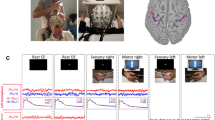Summary
The primary projection areas in the human somatosensory cortex activated by electrical stimulation of the digits of the hand and the ankle were localized by measuring the magnetic field outside the head contralateral to the side of stimulation. Most of the spatial variation in the amplitude of the field component normal to the scalp could be accounted for by representing each source as a single current dipole in a spherical conducting medium with solely concentric variations in electrical conductivity, although the fit of this model to the data showed some statistically significant deviations. Based on the best-fitting parameter values of the model, we found that the projection areas of the thumb, the index finger, the little finger and the ankle were located at successively more medial positions along the primary somatosensory cortex, at an average depth of 2.2 cm from the scalp surface.
Similar content being viewed by others
References
Allison T, Goff WR, Williamson PD, VanGilder JC (1980) On the neural origin of the early components of the human somatosensory evoked potential. In: Desmedt J (ed) Progress in clinical neurophysiology, vol 7, pp 51–68. Karger, Basel, Switzerland
Brenner D, Williamson SJ, Kaufman L (1975) SQUID system for detecting evoked magnetic fields of the human brain. IEEE Trans Magn MAG-13: 365–368
Brenner D, Lipton J, Kaufman L, Williamson SJ (1978) Somatically evoked magnetic fields of the human brain. Science 199: 81–83
Chandler JP (1965) STEPIT, Indiana University
Cohen D, Edelsack EA, Zimmerman JE (1970) Magnetocardiograms taken inside a shielded room with a superconducting point-contact magnetometer. Appl Phys Lett 16: 278–280
Cohen D, Hosaka H (1976) Magnetic field produced by a current dipole. J Electrocardiol 9: 409–417
Delmas A, Petuiset B (1959) Cranio-cerebral topometry in man. Thomas, Springfield
Foerster O (1931) The cerebral cortex in man. Lancet 221: 309–312
Geselowitz DB (1970) On the magnetic field generated outside an inhomogenous volume conductor by internal current sources. IEEE Trans Magn MAG-6: 346–347
Goff WR, Allison T, Vaughan HG (1978) The functional neuroanatomy of event-related potentials. In: Callaway E, Tueting P, Koslow SH (eds) Event-related brain potentials in man. Academic Press, New York
Grynszpan F, Geselowitz DB (1973) Model studies of the magnetocardiogram. Biophys J 13: 911–925
Hari R, Hamalainen M, Kaukoranta E, Reinikainen K, Teszner D (1983) Neuromagnetic responses from the second somatosensory cortex in man. Acta Neurol Scand 68: 207–212
Kaufman L, Okada YC, Tripp J, Weinberg H (1984) Evoked neuromagnetic fields. Ann NY Acad Sci (in press)
Llinás R, Nicholson C (1974) Analysis of field potentials in the central nervous system. In: Remond A (ed) Handbook of Electroencephalography and Clinical Neurophysiology. Elsevier, Amsterdam 2B: 61–83
Maclin EL (1982) Topography of visually evoked magnetic responses of the human brain. Ph.D. Thesis, New York University
Merzenich MM, Kaas JH, Sur M, Lin C-S (1978) Double representation of the body surface within cytoarchitectonic areas 3b and 1 in “SI” in the owl monkey (Actus trivirgatus). J Comp Neurol 181: 41–74
Movshon JA (1982) GRID 3: Perspective projection of a three dimensional surface. Dept. Psychology, New York University
Okada YC (1983) Neurogenesis of evoked magnetic fields. In: Williamson SJ, Romani G-L, Kaufman L, Modena I (eds) Biomagnetism: An interdisciplinary approach. Plenum, New York
Penfield W, Boldrey E (1937) Somatic motor and sensory representation in the cerebral cortex of man as studied by electrical stimulation. Brain 60: 389–443
Penfield W, Rasmussen T (1950) The cerebral cortex of man. Macmillan, New York
Powell TPS, Mountcastle VB (1959a) The cytoarchitecture of the postcentral gyrus of the monkey Macaca mulatta. Bull Johns Hopkins Hosp 105: 108–131
Powell TPS, Mountcastle VB (1959b) Some aspects of the functional organization of the cortex of the postcentral gyrus of the monkey: a correlation of findings obtained in a single unit analysis with cytoarchitecture. Bull Johns Hopkins Hosp 105: 133–162
Romani G-L, Williamson SJ, Kaufman L, Brenner D (1982) Characterization of the human auditory cortex by the neuromagnetic method. Exp Brain Res 47: 381–393
Werner G, Whitsel BL (1968) Topography of the body representation in somatosensory area I of primates. J Neurophysiol 31: 856–869
Whitsel BL, Dreyer DA, Roppolo JR (1971) Determinants of the body representation in the postcentral gyrus of macaques. J Neurophysiol 34: 1018–1034
Williamson SJ, Kaufman L (1981a) Evoked cortical magnetic fields. In: Erné SN, Hahlbohm HD, Lubbig H (eds) Biomagnetism. de Gruyter, Berlin, pp 353–402
Williamson SJ, Kaufman L (1981b) Biomagnetism. J Mag Mag Mat 22: 129–202
Wood CC (1982) Application of dipole localization methods to source identification of human evoked potentials. Ann NY Acad Sci 388: 139–155
Woolsey CN (1947) Patterns of sensory representation in the cerebral cortex. Fed Proc 6: 437–441
Woolsey CN, Marshall WH, Bard P (1942) Representation of cutaneous tactile sensibility in the cerebral cortex of the monkey as indicated by evoked potentials. Bull Johns Hopkins Hosp 70: 399–441
Author information
Authors and Affiliations
Additional information
This research was supported in part by ONR grant N00014-76-C-0568
The preliminary results from the present study were reported at the Sixth Conference on Slow Potentials in the Human Brain held in 1981 (Kaufman et al. 1984) and at the Fourth Workshop on Biomagnetism held in 1982 (Okada 1983)
Rights and permissions
About this article
Cite this article
Okada, Y.C., Tanenbaum, R., Williamson, S.J. et al. Somatotopic organization of the human somatosensory cortex revealed by neuromagnetic measurements. Exp Brain Res 56, 197–205 (1984). https://doi.org/10.1007/BF00236274
Received:
Accepted:
Issue Date:
DOI: https://doi.org/10.1007/BF00236274




